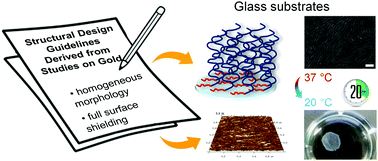当前位置:
X-MOL 学术
›
J. Mater. Chem. B
›
论文详情
Our official English website, www.x-mol.net, welcomes your feedback! (Note: you will need to create a separate account there.)
Transfer of functional thermoresponsive poly(glycidyl ether) coatings for cell sheet fabrication from gold to glass surfaces†
Journal of Materials Chemistry B ( IF 7 ) Pub Date : 2018-02-14 00:00:00 , DOI: 10.1039/c7tb03263c Silke Heinen 1, 2, 3, 4 , Simon Rackow 1, 2, 3, 4 , Jose Luis Cuellar-Camacho 1, 2, 3, 4 , Ievgen S. Donskyi 1, 2, 3, 4, 5 , Wolfgang E. S. Unger 4, 5, 6, 7 , Marie Weinhart 1, 2, 3, 4
Journal of Materials Chemistry B ( IF 7 ) Pub Date : 2018-02-14 00:00:00 , DOI: 10.1039/c7tb03263c Silke Heinen 1, 2, 3, 4 , Simon Rackow 1, 2, 3, 4 , Jose Luis Cuellar-Camacho 1, 2, 3, 4 , Ievgen S. Donskyi 1, 2, 3, 4, 5 , Wolfgang E. S. Unger 4, 5, 6, 7 , Marie Weinhart 1, 2, 3, 4
Affiliation

|
Thermoresponsive polymer coatings can facilitate cell sheet fabrication under mild conditions by promoting cell adhesion and proliferation at 37 °C. At lower temperatures the detachment of confluent cell sheets is triggered without enzymatic treatment. Thus, confluent cell sheets with intact extracellular matrix for regenerative medicine or tissue engineering applications become available. Herein, we applied the previously identified structural design parameters of functional, thermoresponsive poly(glycidyl ether) brushes on gold to the more application-relevant substrate glass via the self-assembly of a corresponding block copolymer (PGE-AA) with a short surface-reactive, amine-presenting anchor block. Both, physical and covalent immobilization on glass via either multivalent ionic interactions of the anchor block with bare glass or the coupling of the anchor block to a polydopamine (PDA) adhesion layer on glass resulted in stable coatings. Atomic force microscopy revealed a high degree of roughness of covalently attached coatings on the PDA adhesion layer, while physically attached coatings on bare glass were smooth and in the brush-like regime. Cell sheets of primary human dermal fibroblasts detached reliably (86%) and within 20 ± 10 min from physically tethered PGE-AA coatings on glass when prepared under cloud point grafting conditions. The presence of the laterally inhomogeneous PDA adhesion layer, however, hindered the spontaneous temperature-triggered cell detachment from covalently grafted PGE-AA, decreasing both detachment rate and reliability. Despite being only physically attached, self-assembled monolayer brushes of PGE-AA block copolymers on glass are functional and stable thermoresponsive coatings for application in cell sheet fabrication of human fibroblasts as determined by X-ray photoelectron spectroscopy.
中文翻译:

将功能性热敏性聚缩水甘油醚涂层从金表面转移到玻璃表面†
热敏性聚合物涂层可通过促进细胞在37°C下的粘附和增殖,在温和条件下促进细胞片的制造。在较低的温度下,无需酶处理即可触发融合细胞片的分离。因此,具有用于再生医学或组织工程应用的完整细胞外基质的融合细胞片变得可用。本文中,我们通过将具有短表面结构的相应嵌段共聚物(PGE-AA)进行自组装,将先前确定的功能性,热响应性聚(缩水甘油醚)刷在金上的结构设计参数应用于与应用相关的基底玻璃上。反应性,呈递胺的锚固嵌段。通过物理和共价固定在玻璃上锚固嵌段与裸露玻璃的多价离子相互作用或锚固嵌段与玻璃上的聚多巴胺(PDA)粘合层的偶联均可产生稳定的涂层。原子力显微镜显示PDA粘附层上共价附着的涂层具有很高的粗糙度,而裸露玻璃上的物理附着的涂层则光滑且呈刷状。在浊点接枝条件下制备时,人类原代皮肤成纤维细胞的细胞片可从玻璃上的物理栓系PGE-AA涂层可靠分离(86%),并在20±10分钟内脱离。但是,横向不均匀的PDA粘附层的存在阻碍了自发温度触发的细胞从共价移植的PGE-AA脱离,从而降低了脱离速率和可靠性。尽管只是身体上的依附,
更新日期:2018-02-14
中文翻译:

将功能性热敏性聚缩水甘油醚涂层从金表面转移到玻璃表面†
热敏性聚合物涂层可通过促进细胞在37°C下的粘附和增殖,在温和条件下促进细胞片的制造。在较低的温度下,无需酶处理即可触发融合细胞片的分离。因此,具有用于再生医学或组织工程应用的完整细胞外基质的融合细胞片变得可用。本文中,我们通过将具有短表面结构的相应嵌段共聚物(PGE-AA)进行自组装,将先前确定的功能性,热响应性聚(缩水甘油醚)刷在金上的结构设计参数应用于与应用相关的基底玻璃上。反应性,呈递胺的锚固嵌段。通过物理和共价固定在玻璃上锚固嵌段与裸露玻璃的多价离子相互作用或锚固嵌段与玻璃上的聚多巴胺(PDA)粘合层的偶联均可产生稳定的涂层。原子力显微镜显示PDA粘附层上共价附着的涂层具有很高的粗糙度,而裸露玻璃上的物理附着的涂层则光滑且呈刷状。在浊点接枝条件下制备时,人类原代皮肤成纤维细胞的细胞片可从玻璃上的物理栓系PGE-AA涂层可靠分离(86%),并在20±10分钟内脱离。但是,横向不均匀的PDA粘附层的存在阻碍了自发温度触发的细胞从共价移植的PGE-AA脱离,从而降低了脱离速率和可靠性。尽管只是身体上的依附,



























 京公网安备 11010802027423号
京公网安备 11010802027423号